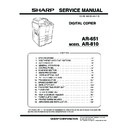Sharp AR-810 (serv.man24) Service Manual ▷ View online
AR-651/810 COPY PROCESS 3 - 3
CCD light
receiving
amount
receiving
amount
Value of
image signals
to be output
image signals
to be output
Light
255
Dark
0
Difference between
"light " and "dark" is
divided into 256
steps.
(3) Scanning
Scanning is a process of exposing the original to
the light and converting the reflection into electrical
signals.
The light reflected from the original is imported to
the charge coupled device (CCD) and this optical
image information is converted into electrical sig-
nals (image signals), which are then sent to the
image processing section.
CCD
Image processing
section
(Example)
쩪
쩪
Rotation of drum
Main charger
Grid control circuit
Discharge
transformer
(2) Charging
Charging is a process of applying a charge uniformly
to the photoconductive drum surface.
The charger wire produces a negative corona dis-
charge, which is controlled by the grid so that the
drum surface is uniformly charged with negative po-
tential.
The surface potential on the drum is determined by
the grid potential and controlled to a specifed value
by the grid control circuit as determined by the proc-
ess controll system.
AR-651/810 COPY PROCESS 3 - 4
(5) Development
Development is a process of making the electro-
static latent images visible to the eye (visible im-
ages).
Developer material is supplied to the photoconduc-
tive drum surface by magnetic roller. The toner in
the developer material adheres to the areas on the
drum surface where the potential is lower than the
developer bias which is applied to the magnetic roller
(reverse development method).
OPC layer
Carrier (always attracted
onto the magnet)
onto the magnet)
Drum
Magnetic roller
Magnet
Magnetic roller
Toner
Toner
Bias voltage
–500 VDC
–500 VDC
OPC
drum
drum
Aluminum conductive
base
base
Toner
(4) Writing
Writing is a process of converting the image signals
sent from the image processing section into optical
signals and exposing the drum surface to the light.
Semiconductor laser elements convert image sig-
nals sent from the image processing section into
optical signals (laser emission) and exposes the
drum surface to the light to form an electrostatic
latent image on it.
Image
processing
section
Laser Drive
board
Semiconduc-
tor laser
element
Polygonal mirror
Photo-
conductive
drum
0
– 100V
– 200V
– 300V
– 400V
– 700V
– 500V
– 600V
Toner amount
applied to the
OPC drum’s
surface
applied to the
OPC drum’s
surface
White background
Half tone
Solid
White background
Image not developed
Bias
potential
potential
Image is developed by
toner
toner
The (–) potential
of the drum being
higher than the
developer bias
of the drum being
higher than the
developer bias
The (–) potential
of the drum being
lower than the
developer bias
of the drum being
lower than the
developer bias
AR-651/810 COPY PROCESS 3 - 5
• Developer material
The developer material is a mixture of toner and
carrier. The toner is charged to negative polarity and
the carrier to positive polarity, due to the friction with
each other caused by mixing.
Toner : Mainly consists of resin and carbon.
Carrier : Consists of ferrite and resin coating on its
surface to provide consistent frictional elec-
trification. (Charge controll)
Carbon
(5~10%)
(5~10%)
[Carrier]
Resin (90~95%)
[Toner]
5~20µm
30~100µm
Ferrite
Note:
If the developer material is used for a long time (be-
yond its normal life span),
the toner is caked onto the carrier.
훹
The carrier’s (charging) performance is lowered.
Symptom: 1. Image density is decreased.
2. Toner scattering occurs.
3. Background fogging occurs.
Solution:
Replace with new developer material.
Toner
Carrier
No frictional electrification
on the area where the toner
is caked on
on the area where the toner
is caked on
• Magnetic roller
- Magnetic brush development -
The south and north poles are arranged inside the
magnetic rollers, as shown in the right figure. This
causes the developer material to form a brush-like
fluff which contacts the photoconductive drum sur-
face.
훹
This is caused by the lines of magnetic force be-
tween the south and north poles.
Lines of
magnetic force
magnetic force
Magnetic roller
OPC drum
N
S
S
AR-651/810 COPY PROCESS 3 - 6
Additional Explanation
The life of the toner cartridge (number of copies) varies depending on the following conditions.
1. Coverage of originals (printing image ratio of the original size) and density of original background
2. Size and density of originals
3. The existence of solid black when making copies (when a book is copied and the original cover is
partially open)
4. Temperature and humidity in the room when making copies
5. Copy density and image quality mode
As indicated in the figure below, the life of the toner cartridge varies depending on the copy mode and
coverage of originals
Type of originals
A.
B.
C.
A
20,000
30,000
40,000
50,000
60,000
70,000
74,000
A
20,000
30,000
40,000
46,000
B
20,000
27,000
15,000
C
A
20,000
30,000
38,000
Click on the first or last page to see other AR-810 (serv.man24) service manuals if exist.

